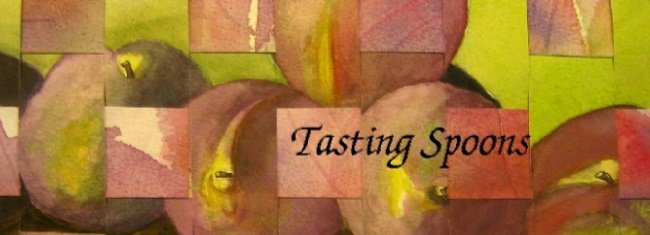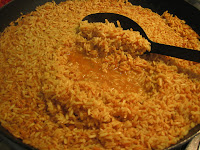Palla, Pella, Paella
I'd never even heard about paella until about 1967. Wow, that's 40 years ago. At the time I was living in Denver, Colorado, and friends had returned from serving 3 years U.S. Navy duty in Rota, Spain. We got acquainted with them and began having dinner at one another's homes on a regular basis. Joan was a good cook, and was happy to share her knowledge about Spanish food she'd learned about and prepared. They had lived "on the economy," meaning they'd lived off the base, in a regular house, not on the U.S. Navy base, so had made friends with a few locals. One particular neighbor shared food with them and showed her how to make some of the Spanish dishes.
So one night Joan and Roger prepared their version of Spanish paella. They also served us her version of Sangria, which I'll share another day. Joan explained that after trying many different kinds of paella in Spain, the only one they really liked was this one which combines chicken, Italian-style sausage and shellfish all together in the one dish. She explained that the flavoring of the sausage added a big boost to the flavor. She also said she varied the kind and amount of fish/shellfish included in it, but it always had to have the chicken drumsticks and sausage added as well.
Happily I began making it and have done so about 15 times over the years. It needs to be made for a crowd as it will feed about 12 people. And I would be remiss if I didn't tell you that this is an expensive dish to make - the more shellfish, the more those dollars add up. Eventually I acquired a paella pan, an inexpensive model from Williams-Sonoma (not available per their website). It was less than $15. And I'd be remiss again if I didn't tell you that this dish does take a moderate amount of prep time. There's a bunch of mincing, chopping and sauteing in several pans, to be done. So leave ample time to complete all those tasks.
Here's a photo of the drumsticks with the onions, yellow bell pepper and garlic. I will admit that over these 40 years I've had some difficulty with the paella - sometimes the rice didn't get cooked. Sometimes the chicken didn't quite get done, and sometimes the shellfish was undercooked. Maybe if this was made out in the open, in the huge paella pans used by the original sheepherders, you'd know it's done because it was stirred more often. Here in the U.S. anyway, the presentation is half the pleasure of serving it - with all of the shrimp tails standing up, the drumsticks arranged artfully in a spoke pattern and the rice buried underneath. I've used scallops and langostinos, squid, fresh clams and fresh mussels too. Just don't use all of those as there's no way you can get them all on top of the rice.
Here's my advice when making paella:
1. cook the rice until it's just a hair's breadth from being done (I do this in a separate pan now);
2. brown and cook the drumsticks until they, too, are just barely done;
3. if using frozen shellfish, defrost it fully first;
4. if covering with foil, leave it tented with a space for steam, as that helps to cook all the fish nestled into the top layer; in other words, form it into a kind of dome;
5. and lastly, cook the Italian sausage until it's lost all of it's pink color, and mince it up into small bite-sized pieces.
Here's a photo of the rice - you must brown the rice before finally finishing the preparation of the paella. It has a really rich color and the steamy flavor from it is SO good. Until I visited Hungary some years ago I didn't know there were so many types of paprika, so I now have the traditional, half sharp and smoked. I used some of the half sharp and the smoked paprika in the paella this time and liked it. I order most of my spices now from Penzey's, and you do know, don't you, that paprika must be kept refrigerated. Little critters love to get into that herb and it loses its flavor left at room temperature. The addition of saffron is essential - it's so very Spanish, and leaves a nice underlying character to the rice.
Finally, you begin pulling it all together. You add the canned clams and sausage to the rice, then all that is poured into the bottom of the paella pan, then the drumsticks are placed in a spoke. Shellfish is strategically placed in and around the drumsticks, tails pointing up. If you add mussels or langostinos, those need to be nestled into the mixture as well. By this time the pan is FULL, let me tell you. Lastly, you throw in a bit of fresh tomato, cover with foil and put into the oven. If the fish is cold, just remember that it takes a bit of time for the entire mixture to heat up enough to cook the fish, so make sure it's done before serving. It always seems to take longer than I think. Take a peek and be certain the shrimp is cooked through. Whisk off the foil and garnish with the reserved minced red bell pepper and peas and serve.
Seafood Paella
Recipe: From my friend Joan Wilson, who lived in Spain during the 1960's
Servings: 12
8 whole chicken drumsticks
1 whole garlic clove -- minced
2 tablespoons olive oil
6 whole saffron threads
1 1/2 cups long-grain white rice
1 pound Italian sausage
1 large onion -- chopped
1 whole green pepper -- chopped
1 3/4 cups low sodium chicken broth
1 cup canned clams -- drained, saved
1 teaspoon salt
1 teaspoon paprika (I use half-sharp)
1 pound fresh shrimp, whole -- tails on
4 whole tomatoes -- sliced
1/2 pound frozen peas. defrosted
1 whole red bell pepper
1. In a very large skillet, brown drumsticks in olive oil, cooking on all sides until chicken is nearly cooked through, then set aside to drain. Dissolve the saffron in about 2 T. of warm water. Set aside. Add sausage to the skillet, cut into bite-sized chunks, and sauté for about 5 minutes. Then add the onion, green bell pepper and garlic and sauté for 5-10 minutes, then remove to a bowl and set aside. In a small bowl set aside about 2 T. of diced red bell pepper, and about 1/4 cup of frozen peas. These will be added at the end.
2. To the frying pan add the rice and sauté it until rice is golden brown. Stir in the chicken broth, clam juice, clams, salt, saffron mixture and paprika and cook for about 10 minutes. Add the onions and green bell pepper to the pan, then frozen peas. Cover pan (or make a tent from aluminum foil) and cook until rice is nearly done. If any of the rice is clinging to the side of the pan, stir them into the liquid. Add the sausage and red bell pepper. Pour the rice mixture into the paella pan and smooth out.
3 Preheat the oven to 375°. Place the chicken drumsticks around the pan (on top of the rice) in a spoke fashion, and nestle them down into the rice a little bit. Shell the shrimp, leave tails intact and butterfly them. Nestle them into the rice with their tails curled up. Place tomato slices wherever there is room, cutting in half if necessary. If needed, add a little more chicken broth to the pan. If you're using mussels and scallops, add those, nestling into the rice as you can. Bake for 20 minutes - just long enough to cook the fish and chicken. Sprinkle the paella with the reserved bell pepper and peas and serve.
Serving Ideas : This meal needs nothing more than a green salad and some bread.
NOTES : This is a really impressive dish - and it feeds a crowd - especially if you add the mussels and scallops. To cut down on the fat, substitute turkey sausage, and use skinless chicken thigh meat. It won't be as pretty (the spoked drumsticks are very eye-catching), but it will taste just as good. You might not think that 1 1/2 cups of rice is sufficient to serve 12, but it is. This isn't going to feed 12 lumberjacks, but it will certainly feed 12 hungry adults. Note that recipe calls for 8 drumsticks - if everybody needs a drumstick, fry up more of them and serve separately, just reheat at the last minute. I usually use the half-sharp paprika - meaning it's half regular and half spicy, which gives this a bit of a bite.
Per Serving: 405 Calories; 19g Fat (43.0% calories from fat); 29g Protein; 27g Carbohydrate; 2g Dietary Fiber; 129mg Cholesterol; 663mg Sodium. Exchanges: 1 1/2 Grain(Starch); 3 1/2 Lean Meat; 1/2 Vegetable; 2 1/2 Fat; 0 Other Carbohydrates.
To view a printable recipe, click on the title at top.





No comments:
Post a Comment